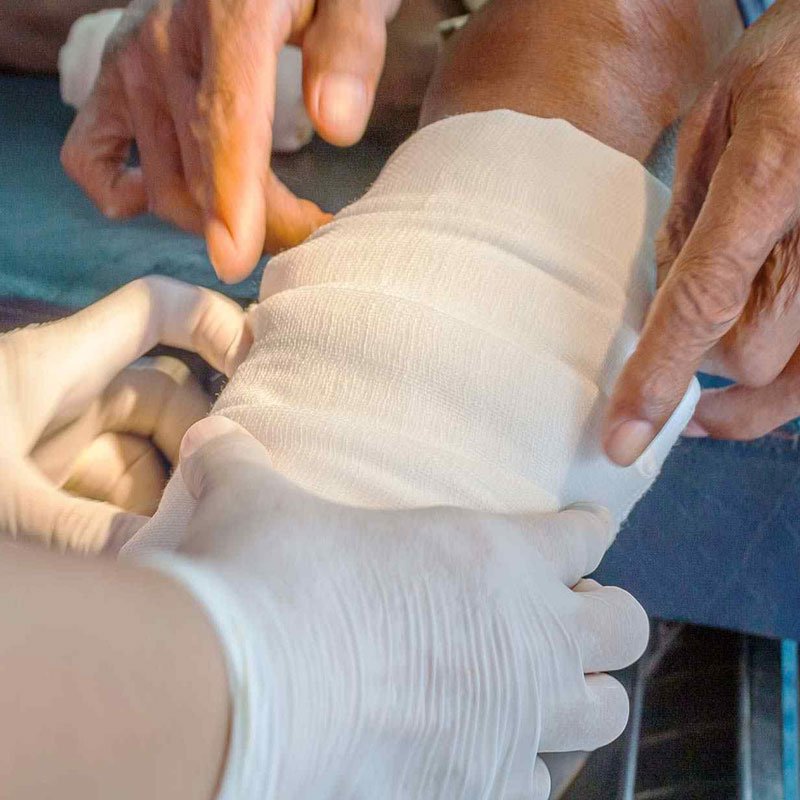Arterial Wound Care & Evaluation
Providing Arterial Wound Care & Evaluation in Arizona
The term “venous wound” encompasses many injury types, including bites, blisters, diabetic wounds, burns, ulcers, and more. These types of wounds take longer to heal due to vascular or circulatory issues. These conditions are also known as arterial insufficiencies and venous insufficiencies.
The expert team of board-certified surgeons and medical practitioners at Arizona Vein and Laser Institute specializes in diagnosing and treating venous wounds and conditions. Using the most advanced technology and state-of-the-art practices in the medical industry, we ensure your treatment is successful. Contact us today to learn more!
Arterial Insufficiency vs. Venous Insufficiency
Venous insufficiencies occur when your veins don’t allow for proper blood flow, causing swelling and other complications, while arterial insufficiencies stem from poor circulation in the arteries. These conditions can lead to slow-healing wounds and other health issues if left untreated.

Non-Healing Venous Wounds
There are several reasons people suffer from wounds that don’t heal without understanding the underlying cause, which is why it’s crucial to visit our top vascular surgeon Dr. Sharma at Arizona Vein and Laser Institute to get a comprehensive evaluation of your veins and arterial blood flow in depth. After your in-depth evaluation, you’ll discuss a treatment plan with Dr. Sharma to determine what will work best for you.
What Treatment for Venous
If you’re suffering from a venous or arterial wound, our vascular doctors will perform a physical examination to determine the treatment plan that will work best for your wound. Your physical exam may include diagnostic testing to help determine your treatment plan. Treatment for arterial ulcers will depend on the severity of the arterial disease. Some of the more common treatments for venous wounds include:
Local Wounds
Local wounds are typically used in cases of chronic venous stasis ulcers. Local wound care involves the sterilization and debridement of the area to reduce the chance of infection or prevent it from worsening in cases of current infection.
Dressings
Dressings are typically used underneath compression bandages to encourage healing, absorb fluids, improve comfort, and prevent your wound from sticking to the bandage. Common dressings include bio-engineered skin substitutes, extracellular matrix dressings, hydro fiber dressings, and acetic acid dressings.
Compression Bandages
We use compression therapy for ulcer prevention and to control swelling, and reduce venous hypertension. Our goal with this type of therapy is to reduce the severity of symptoms and slow the progression of the disease. We may use ultrasound screenings to rule out any potential deep vein thrombosis.
Antibiotics
Bacterial infections are known for causing wounds to heal slowly. If your infection is severe, your doctor may recommend oral antibiotics for wound-bed infections and cellulitis.
Surgery
In some cases, your doctor may recommend surgery to reduce venous reflux, speed up healing, and prevent the recurrence of ulcers. Surgical options for venous wounds include vein ablation, endoscopic surgery, stenting, laser therapy, sclerotherapy, phlebectomy, and more.
The Four Phases of Wound Healing
When you’re dealing with arterial and venous wounds, it can help to understand the healing process. The stages of healing include:
Phase 1: Hemostasis
The first phase of healing, called hemostasis, begins as soon as the injury occurs. During this phase, your body’s goal is to stop the bleeding and contact between platelets and collagen. During this phase, the blood begins to clot at the wound site, which slows and eventually stops the bleeding.
Phase 2: Defensive / Inflammatory Phase
Once the bleeding has stopped, your body focuses on destroying bacteria and removing debris, ultimately getting the wound bed ready to grow new tissues. This phase lasts for approximately four to six days and can involve swelling, reddening of the skin, and pain.
Phase 3: Proliferative Phase
Once the wound is cleared out, your body begins to focus on filling and covering the wound with connective tissues, new blood vessels, and the growth of epithelium. This phase can last anywhere from four to 24 days, depending on the severity of the arterial or venous wound and your overall health.
Phase 4: Maturation Phase
During the final phase in the health process, your body begins to reorganize and remodel cells to increase the strength and flexibility of the skin. The duration of this phase can vary from 21 days to two years, depending on the injury’s severity and your overall health.
Contact us today and schedule your treatment at any of our locations here at Arizona Vein and Laser Institute.
Visit the Arizona Vein & Laser Institute Today
At Arizona Vein & Laser Institute, we use the most advanced technology, and our Board-Certified Physicians have well over 40 years of circulatory system experience in solving any chronic venous disease problems. Whether you need treatment for spider veins or Peripheral Arterial Disease (PAD), we can help you. We proudly serve patients throughout Phoenix and the surrounding areas, including Mesa, Chandler, Glendale, Surprise, and Avondale, AZ. Contact us today to learn more or schedule an appointment!
Customer Reviews
I had some bad varicose veins done two years ago.as my legs hurt and I have a family history of varicose veins. Now I have a few more that have gone bad and have returned to take care of those as they make my legs ache all the time. Dr. Sharma and staff are awesome. Everything is explained throughly and they are very patient.
Been going here for a while now - the staff and Dr. Sharma are great!
